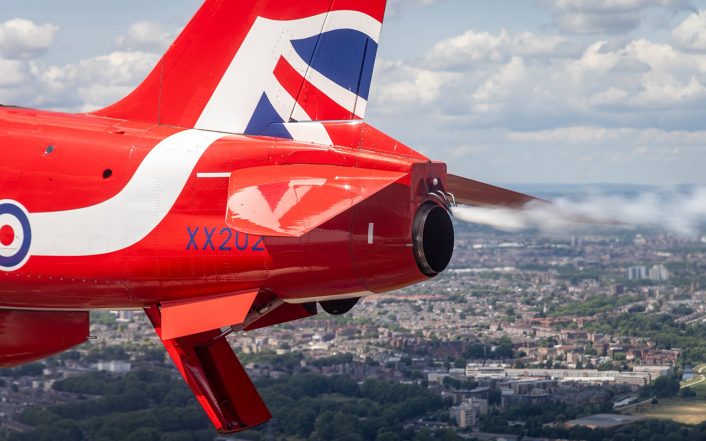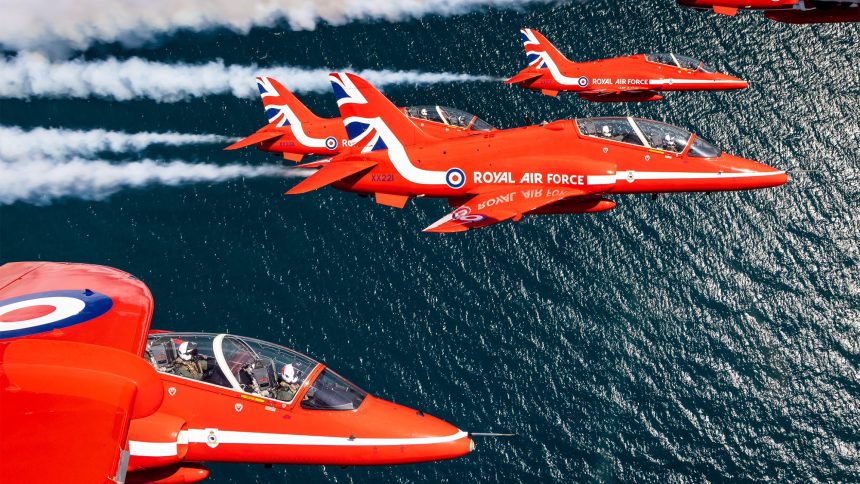For the first time ever during a display, the RAF Red Arrows will fuel their jets with Sustainable Aviation Fuel at 2025’s Royal International Air Tattoo. The usually diesel-fueled smoke pod will also switch to a biofuel based on vegetable oil.
Sustainable Aviation Fuel (SAF) has been trialed by the Royal Air Force since 2020, when the Ministry of Defence’s aviation fuel standards were updated to permit its use in defence aircraft. Blends of conventional fuel and SAF have since been used to fill Typhoon fighter aircraft, P-8 Poseidon maritime patrol aircraft, and C-130 transports (retired 2023) – including delivery through air to air refueling. A 100% sustainable fuel flight took place in November 2022 utilising an A330 Voyager from RAF Brize Norton.
SAF can reduce the carbon emissions generated by an aircraft by around 80%. It is produced from agricultural and industrial byproducts, including waste cooking oils, animal fats, and even municipal solid waste. While helping to fulfil government and service objectives related to combating climate change, SAF also provides a way to reduce reliance on foreign supplies of crude oil and general fossil fuel products. It is designed to blend with conventional fuel to allow mixed supplies, easing logistical burdens, and offer the opportunity of a gradual introduction.
The Red Arrows’ planned full display powered by sustainable fuel at the Royal International Air Tattoo (RIAT), the UK’s largest airshow, follows a successful flypast conducted over London in June using a SAF blend.
We’re very excited to announce that the @rafredarrows are set to feature a world-first at RIAT25 this year, as their iconic display will be done on Sustainable Aviation Fuel (SAF)! ✈️
Their performances across the weekend will be history-making for any national aerobatic team,… pic.twitter.com/Jd0k99vRaT
— Royal International Air Tattoo (@airtattoo) July 9, 2025
Squadron Leader Andy King, Senior Engineering Officer for the Red Arrows team, said “At the heart of the Royal International Air Tattoo is a mission to inspire future generations of aviators – a goal shared by the Red Arrows.”
“This makes this year’s Air Tattoo an ideal occasion to showcase the Red Arrows’ ground-breaking, world-leading move to more sustainable fuels – powering a display that has the same thrilling, entertaining and exciting aerobatics and teamwork that has captivated millions of enthusiasts at the show across the decades.”
Three displays will be flown at RIAT using sustainable fuel, along with a number of formation flypasts over the weekend. The Royal Air Force Typhoon display team will also use a SAF blend, mirroring their first use of the fuel during last years’ display. At that time, Air Vice-Marshal Shaun Harris remarked that “As well as contributing to reduced carbon emissions as part of the Defence Aviation Net Zero Strategy, our ability to use new fuels ensures that the Royal Air Force can continue to operate anywhere we are needed globally.”
At RIAT24, the Typhoon made history with its first public flight using a blend of sustainable aviation fuel! ⛽
What did you think of the display? 🤩 pic.twitter.com/kXfpcA9eYp
— Royal International Air Tattoo (@airtattoo) September 5, 2024
In addition to using SAF to power the aircraft, the Red Arrows’ signature red, white, and blue smoke will also be generated using sustainable Hydrotreated Vegetable Oil (HVO) fuel. This fuel is carried in a pod underneath the teams’ Hawk T1 aircraft, and is injected into the engine exhaust through three small pipes. The instant vaporization of the fuel creates a thick white smoke trail – dye is added to two of the three tanks inside the belly pod to create the red and blue trails. Each aircraft can generate five minutes of white smoke, and one minute each of red and blue.

Making the smoke trails ‘green’ has been an aim for the team since at least 2022, as part of the Royal Air Force’s overall aim to be a net-zero force by 2040. As stated above, this strategy is important both from a climate perspective as well as from a national security one.
Sustainable fuels in other forces
The Royal Air Force is not alone in seeking the expansion in use of sustainable fuels. The U.S. Department of Defense has issued a number of contracts seeking development work in this area, eyeing similar goals to the RAF in reducing reliance on singular fuel sources. It’s additionally noted that SAF could be a safer option, able to be produced at airfields themselves essentially on demand and reducing the need for extremely vulnerable fuel transport trucks.
Lockheed Martin cleared the F-35 Lightning II for synthetic fuels in January of this year, with Norway becoming the first operator of the aircraft to utilize the fuel in their aircraft.
Reducing reliance on fossil fuels and making energy use more efficient is a win-win for NATO and the environment.
5⃣ ways #NATO is making its military camps sustainable. pic.twitter.com/vfqp1QBCmf
— NATO (@NATO) February 10, 2020
Commercial aviation is also investing in sustainable fuels. Virgin Atlantic completed their first transatlantic flight with SAF in 2023, using a Boeing 787 flying a routine service between London Heathrow Airport and New York John F. Kennedy Airport. The flight took place in cooperation with the UK Government and with support from aircraft and engine manufacturers Boeing and Rolls-Royce.
Sustainable fuels are hoped to allow traditional aircraft engines to continue in service for decades to come without impacting climate change related commitments. Alternative methods of aircraft propulsion, for example using purely electrical power, are now in active use but still not practical on a larger scale.









